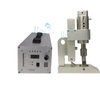
loading












| Availability: | |
|---|---|
| Quantity: | |
RPS-FC35
RPS-SONIC
| Place of Origin | CHINA |
|---|---|
| Brand Name | RPS-SONIC |
| Certification | CE |
| Model Number | RPS-S40 |
| Minimum Order Quantity | 1SET |
| Price | Negotiation |
| Packaging Details | FOAM AND CARTON |
| Delivery Time | 3DAYS after Payment |
| Payment Terms | T/T, Western Union, MoneyGram, PAYPAL |
| Supply Ability | 500 SETS PER MONTH |
Ultrasonic cutting equipment consists of ultrasonic transducer, horn, tool head, and driving power supply. Ultrasonic waves generate energy with a vibration of 20khz-40khz. The cutting edge is bonded at the same time, so the cutting point will not produce burrs like conventional cutting. The cutting point will produce a molten plasticized edge, which can avoid cloth edge wear or burrs. Cutting The speed is fast and the cutting effect is good. It can cut products within 0.1-2mm. The thinner the better, the faster the speed. There are 28khz 30k35khz 40khz available, and different frequencies can be selected according to different materials.
| Frequency | 30Khz |
|---|---|
| Frequency adjustment | Auto-tracking type |
| Max. power output | 300W |
| Power output | Infinitive adjustment |
| Power supply | AC200V 50/60Hz |
| Electricity consumption | 1000VA |
| Outer dimension (mm) | 120*120*380 |
| External control | on/off, Emergency stop, Change of output |
| Weight | 8kg |
| Blade thickness | 0.6mm |
Main advantages of ultrasonic fabric cutting equipment
1. Good cutting effect, very smooth cutting edge, automatic edge fusion.
2. Fast cutting speed, reduced work intensity, and cost saving.
3. Simple operation, handheld cutting or installed on machinery.
4. The host power is adjustable, the frequency range is wide, and the frequency tracking is automatic.
5. The host and transducer have low heat generation and can work continuously.
The synthetic fabrics that work best with ultrasonic cutting machinery are those that contain thermoplastics with similar melting temperatures and compatible molecular structures. In order for the ultrasonic cutting to work properly, synthetic fabrics should all share the following characteristics:
– Wide melting range
– High friction coefficient
– Uniform thickness
– At least 25 % of thermoplastic contents
– Enough stiffness and thickness to take the energy on the material’s interface (0,32258 mm / 0,0127 mm minimum).
Polyester is considered to be the most suitable synthetic material to be subjected to ultrasonic applications. Moreover, ultrasounds can generate strong and long-lasting seams in synthetic elements like Nylon 6 and Nylon 6/6 as well. Most polyolefins (polypropylene and polyethylene), on the other hand, show excellent welding characteristics, plus they are very lightweight. This makes them to lend themselves to various industrial uses.
Advantages:
– Easy of use and steady production results
– It seal off drape borders immediately
– Avoiding any unwanted fraying
– Efficient space optimization
– Guarantees quick, clean solutions without emitting hazardous fumes.
Ultrasonic cutting equipment consists of ultrasonic transducer, horn, tool head, and driving power supply. Ultrasonic waves generate energy with a vibration of 20khz-40khz. The cutting edge is bonded at the same time, so the cutting point will not produce burrs like conventional cutting. The cutting point will produce a molten plasticized edge, which can avoid cloth edge wear or burrs. Cutting The speed is fast and the cutting effect is good. It can cut products within 0.1-2mm. The thinner the better, the faster the speed. There are 28khz 30k35khz 40khz available, and different frequencies can be selected according to different materials.
| Frequency | 30Khz |
|---|---|
| Frequency adjustment | Auto-tracking type |
| Max. power output | 300W |
| Power output | Infinitive adjustment |
| Power supply | AC200V 50/60Hz |
| Electricity consumption | 1000VA |
| Outer dimension (mm) | 120*120*380 |
| External control | on/off, Emergency stop, Change of output |
| Weight | 8kg |
| Blade thickness | 0.6mm |
Main advantages of ultrasonic fabric cutting equipment
1. Good cutting effect, very smooth cutting edge, automatic edge fusion.
2. Fast cutting speed, reduced work intensity, and cost saving.
3. Simple operation, handheld cutting or installed on machinery.
4. The host power is adjustable, the frequency range is wide, and the frequency tracking is automatic.
5. The host and transducer have low heat generation and can work continuously.
The synthetic fabrics that work best with ultrasonic cutting machinery are those that contain thermoplastics with similar melting temperatures and compatible molecular structures. In order for the ultrasonic cutting to work properly, synthetic fabrics should all share the following characteristics:
– Wide melting range
– High friction coefficient
– Uniform thickness
– At least 25 % of thermoplastic contents
– Enough stiffness and thickness to take the energy on the material’s interface (0,32258 mm / 0,0127 mm minimum).
Polyester is considered to be the most suitable synthetic material to be subjected to ultrasonic applications. Moreover, ultrasounds can generate strong and long-lasting seams in synthetic elements like Nylon 6 and Nylon 6/6 as well. Most polyolefins (polypropylene and polyethylene), on the other hand, show excellent welding characteristics, plus they are very lightweight. This makes them to lend themselves to various industrial uses.
Advantages:
– Easy of use and steady production results
– It seal off drape borders immediately
– Avoiding any unwanted fraying
– Efficient space optimization
– Guarantees quick, clean solutions without emitting hazardous fumes.








Ultrasonic Welding Equipment Ultrasonic Welding Transducer Ultrasonic Welding Converter Ultrasonic Liquid Processor Ultrasonic Cutting Equipment Ultrasonic Spray Nozzles Ultrasonic Power Supply Ultrasonic Soldering Equipment Ultrasonic Welding Horn Ultrasonic Assisted Machining Ultrasonic Testing Equipment